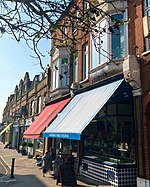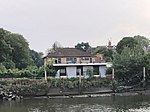Church of St Margaret of Scotland, Twickenham
The Church of St Margaret of Scotland, also known as St Margarets Catholic Church, is a Roman Catholic church on St Margaret's Road in St Margarets, Twickenham, in the London Borough of Richmond upon Thames. The parish was created in 1936. The church building was designed by the architect Austin Winkley who was an influential architect of the Liturgical Movement. It opened in 1969. In 1999 it became a Grade II listed building.The church is named after the 11th-century English Saxon princess who became Queen of Scotland when she married Malcolm III and who was canonised by Pope Innocent IV in 1250.Mass is held on Saturday and Sunday evenings and every morning except on Thursdays.
Excerpt from the Wikipedia article Church of St Margaret of Scotland, Twickenham (License: CC BY-SA 3.0, Authors).Church of St Margaret of Scotland, Twickenham
St Margarets Road, London Twickenham (London Borough of Richmond upon Thames)
Geographical coordinates (GPS) Address External links Nearby Places Show on map
Geographical coordinates (GPS)
| Latitude | Longitude |
|---|---|
| N 51.4562 ° | E -0.3199 ° |
Address
St.Margaret of Scotland RC Church
St Margarets Road 130
TW1 1RL London, Twickenham (London Borough of Richmond upon Thames)
England, United Kingdom
Open on Google Maps










